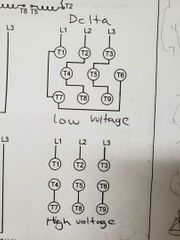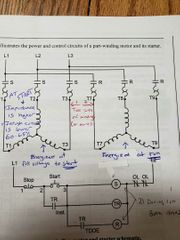![]()
![]()
![]()
Use LEFT and RIGHT arrow keys to navigate between flashcards;
Use UP and DOWN arrow keys to flip the card;
H to show hint;
A reads text to speech;
18 Cards in this Set
- Front
- Back
|
Three-phase mutli-lead motors |
·Single-voltage motors have a stator that has three windings or three groups of windings
·Dual-voltage motors have six windings or groups of winding; two windings or groups for each phase (connected in series for 460V or parallel 230V) |
|
|
Single-voltage motors. |
·Have six leads. ·Grouped T1&T4, T2&T5, T3&T6 ·T1,T2 and T3 are winding starts ·T4,T5 and T6 are winding finishes ·IEC labels U, V and W ·T4,T5 & T6 not brought to connection box U1|T1 V1|T2 W1|T3 | | | | | | U2|T4 V2|T5 W2|T6
|
|
|
Dual-voltage motors |
·Have 12 leads. ·Only T1-T9 are brought out to connection box ·T10, T11 & T12 remain in the stator ·Dual-voltage 3phase, single speed motors are labeled 230V/460V on the nameplate ·Nine-lead wye motor ·Nine-lead delta motor
|
|
|
Nine-lead 230/460V Wye connections |

|
|
|
Nine-lead 230/460V Delta connections |

|
|
|
For both Wye & Delta connections |
The winding connections are connected in parallel for low-voltage and series for high-voltage |
|
|
Motor direction of rotation |
·Interchanging any two supply leads changes the direction of rotation of a 3-phase motor
·T1, T2 & T3 connected to lines whose phase sequance is L1, L2 & L3 (ABC) counter-clockwise
·T1,T2 & T3 connected to lines whose phase sequance is L3, L2 & L1 (CBA) clockwise |
|
|
Motor Starters |
Can be either: ·Across-the-line starters (apply full voltage to the motor at start) ·Reduced-voltage starters (provide reduced voltage at start & full voltage at run) |
|
|
Across-the-line (full voltage) starters |
·Across-the-line produces starting current that is 500% - 600% of the full load current
·And starting torque that is 150% of the full load torque
|
|
|
Across-the-line (full voltage) starters |
·Across-the-line connects the motor leads directly across the supply
Style of starter may be: ·Manual (open/close switch) ·Magnetic (electrically operated switch - contactor)
·CEC requires a manual disconnecting means on the line side of the magnetic motor starter in the circuit |
|
|
Part-Winding Starters & Motors (Across the line) |
·This type of starter is for loads with small to no load at start
·If full load is present, the motor could be damaged if the starter does not energize both windings within 2 seconds
·Six conductors required between the starter & motor (the leads are T1, T2, T3, T7, T8, & T9) ·reduces starting torque more than it reduces starting current |
|
|
Part-Winding Starters & Motors (Across the line) |

Reduced to 60-65% of the inrush current (if both windings were energized at the same time) |
|
|
Reduced-Voltage Starters |
·Used when the high starting current of a motor can cause excessive volt drop or volt sag (lights dim) ·Reduces inrush starting current ·Reduces starting torque (can be a problem if too much mechanical load on shaft) ·Smoother acceleration & quieter starts ·May require timing relays in the control circuit |
|
|
Timing Relays |
·Time delay on energization (TDOE) aka On-delay relay occurs after the relay coil is energized ·Time delay on de-energization (TDOD) aka Off-delay occurs after the relay coil is de-energized ·TO (timed to open) ·TC (timed to close) ·Contact moves in direction of arrow after timing is complete |
|
|
Autotransformer Starters Calculations |
Starting voltage of the motor (Vrv) is proportional to starting current of the motor (Im) 384 Vrv 4.8 = ------ 80 A (motor)
Starting voltage (VFv) is proportional to the line current (IL) 480 VFv 4.8 = ------ 64 A (line)
|
|
|
Autotransformer Starters Calculations |
·Apparent power of motor: S = V (at motor) × I (at motor)
·Autotransformers can have 80%, 65%, or 50% taps
·Line current calculation: (384)2 (Starting current)-->100A × (------) (480) ·80% tap, plus squared -->.802 = 0.64 <--Starting torque ·Find starting torques by using taps |
|
|
Autotransformer Open & Closed Starter Transitions |
·Open-transition momentarily disconnect the motor during transition from reduced-voltage to full-voltage
·Open-transition have higher transition currents & higher torque changes (torque bump)
·Closed-transition maintain current to the motor during transition from reduced-voltage to full-voltage
·Closed-transition offers better performance |
|
|
Wye-Delta Starting |
·The motors three windings (T1 to T6) or groups are connected in Wye for starting, and are reconnected in delta for running |

